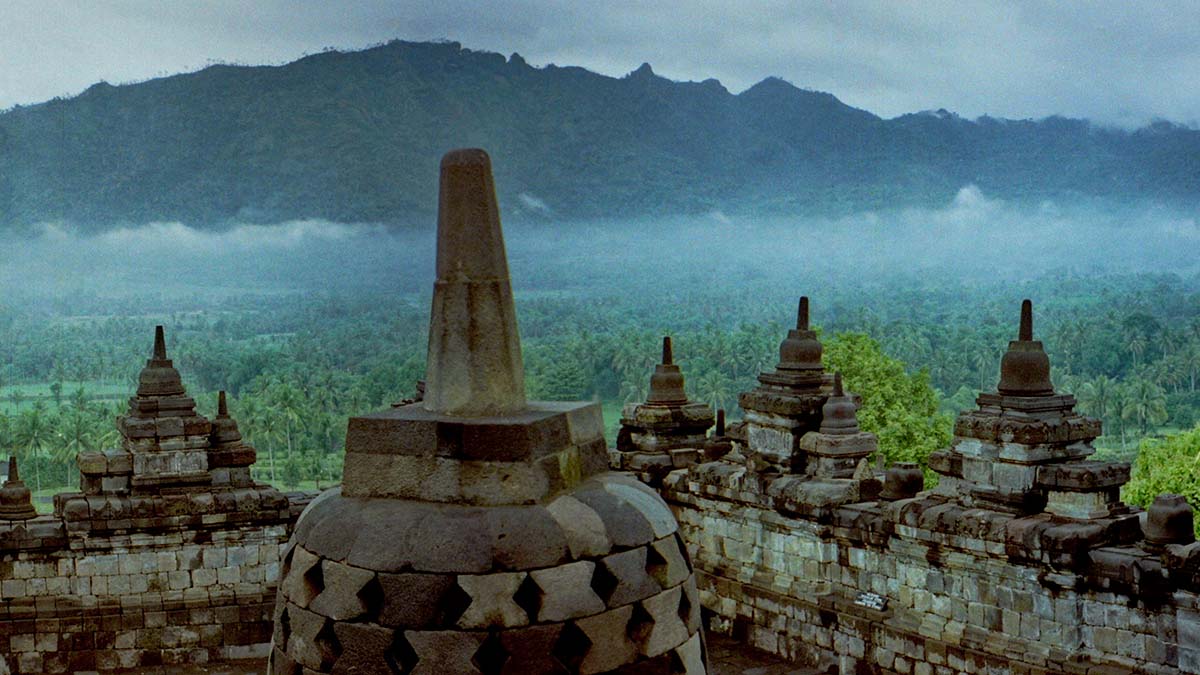
by Kris Williamson
Curled up in a fetal position, I shivered through the night. With only my sweat-dampened clothes to keep me warm, I wondered why I was so cold in the tropics. It was the middle of the night, and I was staying in a Javanese losmen, the kind of place that has four walls, a roof, a mattress, and an endless supply of mosquitoes.
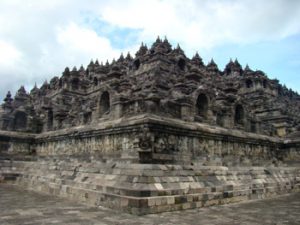 After four hours of trying to sleep, I cursed my alarm for dashing that hope. My short, sleepless night bled into what would be a long and memorable day.
After four hours of trying to sleep, I cursed my alarm for dashing that hope. My short, sleepless night bled into what would be a long and memorable day.
I dressed and packed my overnight bag as the mosquitoes took their last nips of me. Outside the losmen I found the Australian backpacker who had convinced me that staying at this place would be a good idea for getting an early start. She looked well-rested. But how? Before I had time to complain about the accommodation, a white minivan pulled up. There was an Italian couple inside. Aside from a brief exchange of hellos, nobody spoke for the remainder of the trip.
I was fairly certain that this was the transport I had booked to take me to Borobudur, the largest Buddhist temple in the world, only forty-five minutes away. My thoughts ran rampant on the drive to this holy site. Would it be checkered with monks in deep-colored robes burning incense? Would there be an ancient ceremony underway when I arrived? Could I find a decapitated Buddha statue, stand behind it, and get someone to take my picture?
 The villages we passed on the way from the Islamic sultanate of Yogyakarta to the host town of Magelang, a small and uninteresting town in central Java, were uninspired and characterless. ‘Humble’ would be a more appropriate description as these towns would have served as the gateway to a center for Buddhist scholarship and worship.
The villages we passed on the way from the Islamic sultanate of Yogyakarta to the host town of Magelang, a small and uninteresting town in central Java, were uninspired and characterless. ‘Humble’ would be a more appropriate description as these towns would have served as the gateway to a center for Buddhist scholarship and worship.
The minivan turned off the two-lane road to a pot-holed one-lane road that would lead to Borobudur. There were short stone stupas beginning to appear alongside the road, a few idle monks, and souvenir shops and makeshift art galleries, though still closed. The sun was still not visible but managed to light the sky a shade of deep blue-grey. I started to see more people and wondered if they were pilgrims making an annual trek. Would I be so inspired that I too would come back to this spot regularly?
The driver stopped in a large dirt lot where a few cars and minivans were parked. I walked to the entrance gates, still unable to see the temple itself.
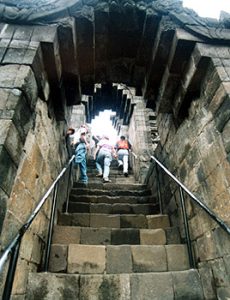 At the ticket counter, I paid the ‘foreigner’ rate and presented my ticket to the smiling man in military dress who stood at the entrance gate. He told me that the gates would open in another ten minutes. I looked to the sky, by now turning a brighter shade of blue with hints of orange as the sun rose. I wanted to be at the top of Borobudur by the time the sun cleared the mountains and volcanoes that flanked the monument from the east.
At the ticket counter, I paid the ‘foreigner’ rate and presented my ticket to the smiling man in military dress who stood at the entrance gate. He told me that the gates would open in another ten minutes. I looked to the sky, by now turning a brighter shade of blue with hints of orange as the sun rose. I wanted to be at the top of Borobudur by the time the sun cleared the mountains and volcanoes that flanked the monument from the east.
The sun rose, and as if he knew what I was wishing, the guard open the gate and let me in. I had missed my chance to reach the summit by sunrise so I took my time strolling through the peripheral gardens. It was not colorful and not very tidy, but the symmetry of the plants on each side of the walkway seemed to give it an orderly appearance. The oil drums cum trash cans scattered around the gardens, however, did nothing to enhance the beauty.
Turning the corner, I found myself on the main path that led straight up to the front of the temple. It was massive, like a layered pyramid of dark grey stone rising out of the dirt. I picked up my pace to get to there quickly until I realized that I didn’t need to rush the moment. I just stopped and stared in wonder.
At the base of the temple, I could see quite clearly that what had looked like layering from afar were indeed layers: nine of them. This pyramid is a series of massive stone platforms stacked on one another, each one smaller than the one it sat upon, with circular platforms at the top. This allowed me to walk around each level individually. The walls are lined with over 2,600 bas relief carvings from stone, telling the story of the Buddha and his teachings. They are large enough to span the circumference of a few football stadiums if stretched out.
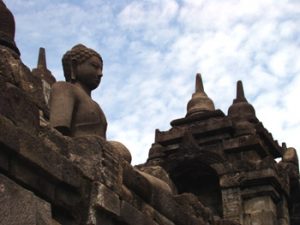 By the time I neared the top of the monument, at the end of the chiseled story, I mentally rejoined the present. The monument was now packed with people. Screaming children were swinging from the stone demon heads which were once used for water runoff. Tourists, both locals and foreign, were taking pictures of themselves and the stone edifices and the hundreds of Buddha statues in various forms of decay around the monument.
By the time I neared the top of the monument, at the end of the chiseled story, I mentally rejoined the present. The monument was now packed with people. Screaming children were swinging from the stone demon heads which were once used for water runoff. Tourists, both locals and foreign, were taking pictures of themselves and the stone edifices and the hundreds of Buddha statues in various forms of decay around the monument.
I had been unaware that the sun was approaching its high-noon position in the sky. I had spent the entire morning in another dimension and awakened to the present day chaos, drenched in sweat. I tried to get to Nirvana, the peak of the monument which had more recently been complimented with a lightning rod, but now it was too crowded with visitors.
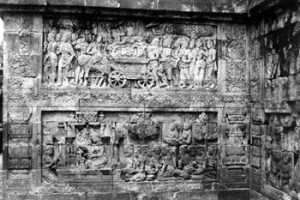 These were not the monks and pilgrims I had expected. These tourists, who had come here for the sights, did not seem to appreciate the significance of the temple. This man made holy mountain had served as the center of the world for the Javanese back in the 9th century. Could they have imagined then that, over a millennia later, its reliefs would be ignored, its statues defaced, and its revered position would be downgraded to a tourist attraction on the extreme outskirts of a regional city?
These were not the monks and pilgrims I had expected. These tourists, who had come here for the sights, did not seem to appreciate the significance of the temple. This man made holy mountain had served as the center of the world for the Javanese back in the 9th century. Could they have imagined then that, over a millennia later, its reliefs would be ignored, its statues defaced, and its revered position would be downgraded to a tourist attraction on the extreme outskirts of a regional city?
That thought bothered me, not as a Javanese or Buddhist, but as a person. I wandered around the monument and its grounds a while longer but did not enjoy the environment as much as I had when I was virtually alone there. I made my way for the exit, turned, took one last photo, and left the gates.
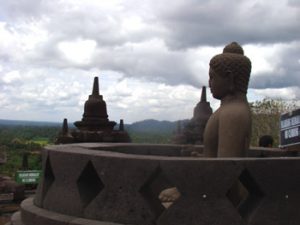 The exit gate was highly symbolic of leaving the illusion of an ancient abode of peace and entering the modern, capitalist-oriented society that had replaced it. The path to the parking lot wound through a market selling souvenirs at overinflated prices. The vendors were aggressive and nullified my relaxed mood. I felt assaulted, verbally accosted from both sides with claims of needing money for rice or to feed babies strapped to their chests with a batik cloth. I kept my head down not wanting to make eye contact. Surely this was not what the teachings and life story of Buddha intricately recorded on the walls of Borobudur had recommended as a path for living one’s life happily.
The exit gate was highly symbolic of leaving the illusion of an ancient abode of peace and entering the modern, capitalist-oriented society that had replaced it. The path to the parking lot wound through a market selling souvenirs at overinflated prices. The vendors were aggressive and nullified my relaxed mood. I felt assaulted, verbally accosted from both sides with claims of needing money for rice or to feed babies strapped to their chests with a batik cloth. I kept my head down not wanting to make eye contact. Surely this was not what the teachings and life story of Buddha intricately recorded on the walls of Borobudur had recommended as a path for living one’s life happily.
I struggled with these thoughts, feeling angry that Borobudur was not treated more respectfully and its message had been disregarded. But there I was myself, a tourist, camera in hand. I got what I wanted from this monument in the end, a new window to view life and human history, albeit nothing more than a superficial glance. And the other tourists and vendors and beggars, were also getting what they wanted from the monument.
Did my trip constitute a pilgrimage? That is difficult to say. But I suppose visiting Borobudur over a thousand years after the rise and fall of its builders’ culture is, at least, a sign of respect for it. And I will go back.
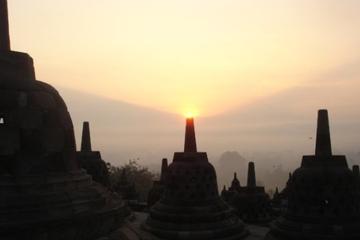
Borobudur Sunrise and Village Tour
If You Go:
HOW TO GET THERE:
Borobudur is in the town of Magelang, a 45 minute drive from Yogyakarta. Door-to-door minivans are easily arranged from Yogyakarta’s tourist areas of Prawirotaman and Sosrowijayan and cost $5 to $6 for the round trip. Public bus #5 from Umbulharjo bus terminal costs a few dollars less but takes twice as long to reach there. Taxis are a pricey option compared to the buses and will require some heavy negotiating. From Bali long and expensive package trips can easily be arranged as well.
WHEN TO GO:
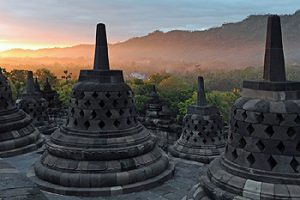 Borobudur opens its entrance gates at 6am, just after sunrise. Some local hotels and losmen in Magelang will charge $5 – 10 extra to get you inside the temple an hour earlier though. This is not legal but is usually not a problem. Sunrise and sunset times offer stunning sky colors for experiencing the temple and are often the least crowded and coolest times of day to go. On the full moon in May, a vibrant procession of monks honoring the birth of the Buddha takes place.
Borobudur opens its entrance gates at 6am, just after sunrise. Some local hotels and losmen in Magelang will charge $5 – 10 extra to get you inside the temple an hour earlier though. This is not legal but is usually not a problem. Sunrise and sunset times offer stunning sky colors for experiencing the temple and are often the least crowded and coolest times of day to go. On the full moon in May, a vibrant procession of monks honoring the birth of the Buddha takes place.
WHAT TO BRING:
Money – The temple entrance fee costs around $10 per person (non-Indonesian) and a camera/video fee may also apply.
Sunscreen and a hat – Once on the temple, there is no shelter from the sun, and it gets quite hot.
Walking shoes – The stairs are numerous and steep here, and a pair of flip-flops will not do you any favors.
ASIDES:
Candi Mendut – This smaller temple sits three kilometers to the east of Borobudur and contains a three meter high stone Buddha statue sitting in a rare position.
Guide – Unless you are a Buddhist scholar, hiring a private guide provides the most informative experience on the hundreds of pictures carved into the temple walls, each piece telling a part of the larger story. Guides can cost from $5 to $10.
Accommodation – There are a few places to stay in Magelang, ranging from losmen for a few dollars per night to luxury resorts starting at $600 and beyond.
Market – Exiting the temple will take you into the market, where very persistent vendors will try to sell you their wares for two or three times the cost of the same items in Yogyakarta. If you are not interested, politely decline and (most importantly) keep walking.
For more information visit the Official Website of Indonesia Tourism – Wonderful Indonesia
About the author:
Kris Williamson is a freelance writer and editor living in Kuala Lumpur, Malaysia. He has traveled extensively throughout Southeast Asia. When not roaming the world, he writes about past travel experiences and tries to figure out where next to travel and which non-direct way to get there.
Photo credits:
First photo of Borobudur in the mist by Bill Fairs on Unsplash
All other photographs by David Ashley and Oscar & Khalil Ayoub.


Joker slot
Holy Borobudur in Muntilan, Java, Indonesia